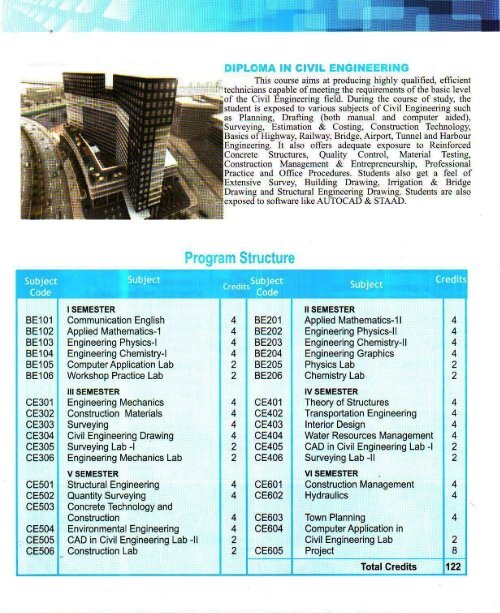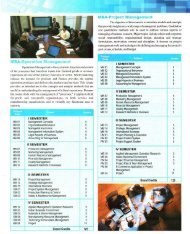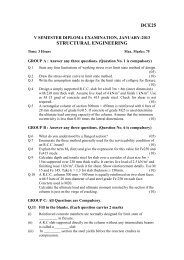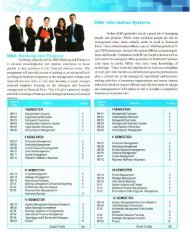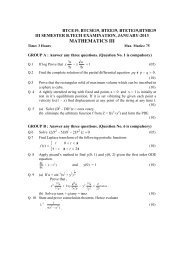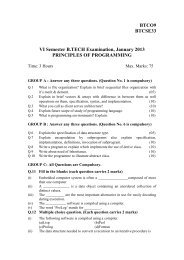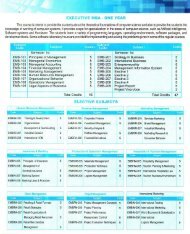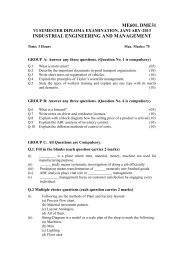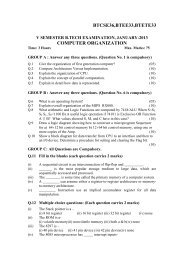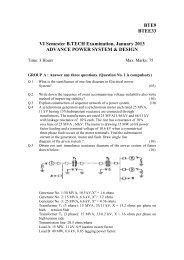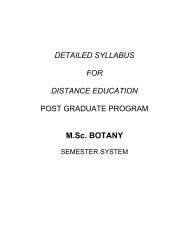Diploma In Civil Engineering - Skymount Distance Education
Diploma In Civil Engineering - Skymount Distance Education
Diploma In Civil Engineering - Skymount Distance Education
Create successful ePaper yourself
Turn your PDF publications into a flip-book with our unique Google optimized e-Paper software.
KARANATAKA STATE OPEN UNIVERSITYDIPLOMA IN CIVIL ENGINEERINGSEMESTER SYSTEMSYLLABUS
I YEAR SYALLBUS(Basic <strong>Engineering</strong>)(Common to all Branches)Subject Code Subject Title Max marks Max CreditsSemester-IBE101 Communication English 100 4BE102 Applied Mathematics-1 100 4BE103 <strong>Engineering</strong> Physics-I 100 4BE104 <strong>Engineering</strong> Chemistry-I 100 4BE105 Computer Application Lab 100 2BE106 Workshop Practice Lab 100 2Semester -IIBE201 Applied Mathematics-1I 100 4BE202 <strong>Engineering</strong> Physics-II 100 4BE203 <strong>Engineering</strong> Chemistry-II 100 4BE204 <strong>Engineering</strong> Graphics 100 4BE205 Physics Lab 100 2BE206 Chemistry Lab 100 2
<strong>Civil</strong> <strong>Engineering</strong>III SemesterSubject Code Subject Title Max marks Max CreditsCE 301 <strong>Engineering</strong> Mechanics 100 4CE 302 Construction Materials 100 4CE 303 Surveying 100 4CE 304 <strong>Civil</strong> <strong>Engineering</strong> Drawing 100 4CE 305 Surveying Lab -I 100 2CE 306 <strong>Engineering</strong> Mechanics Lab 100 2IV SemesterSubject Code Subject Title Max marks Max CreditsCE 401 Theory of Structures 100 4CE 402 Transportation <strong>Engineering</strong> 100 4CE 403 <strong>In</strong>terior Design 100 4CE 404 Water Resources Management 100 4CE 405 CAD in <strong>Civil</strong> <strong>Engineering</strong> Lab -I 100 2CE 406 Surveying Lab -II 100 2
V SemesterSubject Code Subject Title Max marks Max CreditsCE 501 Structural <strong>Engineering</strong> 100 4CE 502 Quantity Surveying 100 4CE 503 Concrete Technology and Construction 100 4CE 504 Environmental <strong>Engineering</strong> 100 4CE 505 CAD in <strong>Civil</strong> <strong>Engineering</strong> Lab -II 100 2CE 506 Construction Lab 100 2VI SemesterSubject Code Subject Title Max marks Max CreditsCE 601 Construction Management 100 4CE 602 Hydraulics 100 4CE 603 Town Planning 100 4CE 604Computer Application in <strong>Civil</strong><strong>Engineering</strong> Lab100 2CE 605 Project 400 8Total Marks = 3800Total Credits = 122
SEMESTER : ISubject Code : BE 101Subject Title : Communication EnglishStructure of the Course ContentBLOCK 1 Grammar (Non-Textual)Unit 1: Functional AnalysisUnit 2: Voice and parts of speechUnit 3: Direct and indirect speechUnit 4: PrepositionBLOCK 2 GrammarsUnit 1: One word substituteUnit 2: Articles and question tagsUnit 3: Prefixes and suffixesUnit 4: TensesBLOCK 3 CompositionsUnit 1: ComprehensionUnit 2: Simple passageUnit 3: Moral storyUnit 4: Science and technologyBLOCK 4 Letter and dialogue WritingUnit 1: Letter writing - personalUnit 2: Letter writing - officialUnit 3: Dialogue writingUnit 4: Hints developmentBLOCK 5 ProsesUnit 1: An Astrloger's day – R.K. NarayananUnit 2: The sun, the planets and the stars – C.JonesUnit 3: The continuing spell of RamanujamUnit 4: On saying 'please' – A.G.GardinerBooks:1. Orient Longman, Anna Salai, Chennai-600002.2. The Advanced Learners Dictionary of Current English by A.S.Hornby, OxfordUniversity Press. 19733. High School English Grammar and Composition by Wren & Martin, S.Chand & CoLtd., 20054. Vocabulary in Practice - Part 1 to 4 by Glennis Pye, Cambridge University Press,5. Learn Correct English by Shiv K. Kumar & Hemalatha Nagarajan, PearsonLongman, 20056. Essential English Grammar by Raymond Murphy, Cambridge University Press,7. Common Errors in English by M.Thomas, Lotus Press, New Delhi, 20068. Basic English Usage by Michael Swan, ELBS/OUP, 19899. Communication Skills for Engineers by Mishra, Ist Edition, Pearson Longman10. Basic English Dictionary by Longman Longman Ist Edition, Pearson Longman
SEMESTER : ISubject Code : BE 102Subject Title : Applied Mathematics - IStructure of the Course ContentBLOCK 1 AlgebraUnit 1: DeterminantsUnit 2: MatricesUnit 3: Permutation and combinationUnit 4: Binomial TheoremBLOCK 2 Complex numbersUnit 1: Real and imaginary partsUnit 2: Demoivre's TheoremUnit 3: Finding the n th roots of unityUnit 4: Solving equationsBLOCK 3 Analytical geometryUnit 1: Pair of straight linesUnit 2: CirclesUnit 3: Family of circlesUnit 4: Concentric circlesBLOCK 4 TrigonometryUnit 1: Compound anglesUnit 2: Multiple anglesUnit 3: Sub multiple anglesUnit 4: Sum and product formulaeBLOCK 5 Differential calculusUnit 1: LimitsUnit 2: DifferentiationUnit 3: Differentiation methodsUnit 4: Successive differentiationBooks :1. <strong>Engineering</strong> Mathematics by Dr M.K.Venkatraman, National Publishing Co.2. <strong>Engineering</strong> Mathematics by Dr P.Kandasamy, S.Chand & Co, New Delhi3. Higher <strong>Engineering</strong> Mathematics by Ramana, Tata McGraw Hill, New Delhi4. <strong>Engineering</strong> Mathematics by Singh, Tata McGraw Hill, New Delhi5. Advanced <strong>Engineering</strong> Mathematics by N.Bali,M.Goyal,C.Watkins,LakshmiPublications (Pvt) Ltd, New Delhi6. <strong>Engineering</strong> Maths by T.Veerarajan, Tata McGraw Hill, New Delhi7. Schaum's Outline of Technical Mathematics by Paul Calter, Tata McGrawHill, New Delhi8. <strong>Engineering</strong> Mathematics Vol-III by Dr. B. Krishna Gandhi , Dr. T.K.VIyengar, S.Ranganatham, , S.Chand & Co, New Delhi9. <strong>In</strong>troduction to <strong>Engineering</strong> Mathematics by H.K. Dass, Dr.Rama Verma,S.Chand & Co, New Delhi10. Applied <strong>Engineering</strong> Mathematics Vol-II by H.K.Dass, S.Chand & Co
SEMESTER : ISubject Code : BE 103Subject Title : <strong>Engineering</strong> Physics - IStructure of the Course ContentBLOCK 1 S I units and StaticsUnit 1: Fundamental quantitiesUnit 2: Derived quantitiesUnit 3: Concurrent forcesUnit 4: parallelogram Law of forcesBLOCK 2 Properties of matterUnit 1: Stress and strainUnit 2: Young's modulusUnit 3: ViscosityUnit 4: Surface TensionBLOCK 3 DynamicsUnit 1: Projectile MotionUnit 2: Angle of projectionUnit 3: Circular MotionUnit 4: Application of circular motionBLOCK 4 Rotational motions of rigidity bodiesUnit 1: Moment of <strong>In</strong>ertiaUnit 2: Kinetic energyUnit 3: Angular MomentumUnit 4: Kepler's LawBLOCK 5 Remote sensing and soundUnit 1: Active and Passive remote sensingUnit 2: Microwave remote sensingUnit 3: Types of sound wavesUnit 4: AcousticsBooks :1. Physics by Resnick and Hoilday ,Wisley Toppan Publishers – England2. Mechanics by Narayana Kurup , S. Chand Publishers – New Delhi3. <strong>Engineering</strong> Physics by B.L. Theraja , S. Chand Publishers – New Delhi4. Remote sensing by Dr.M.Anji Reddy, Jawaharlal Nehru TechnologicalUniversity –Hyderabad.5. <strong>Engineering</strong> Physics by V.Rajendran, Tata McGraw Hill, New Delhi6. <strong>Engineering</strong> Physics by Vikram Yadav, Tata McGraw Hill, New Delhi7. Schaum's Outline of Physics for <strong>Engineering</strong> and Science by MichaelBrowne, Tata McGraw Hill, New Delhi8. Modern <strong>Engineering</strong> Physics by A.S.Vasudeva, S. Chand Publishers, NewDelhi9.<strong>Engineering</strong> Physics Fundamentals & Modern Applications by P.Khare andA.Swarup, Lakshmi Publications (Pvt) Ltd, New Delhi10. <strong>Engineering</strong> Physics by Dipak Chandra Ghosh,Nipesh ChandraGhosh,Prabir Kumar Haldar, Lakshmi Publications (Pvt) Ltd, New Delhi
SEMESTER : ISubject Code : BE 104Subject Title : Applied Chemistry - IStructure of the Course ContentBLOCK 1 Acids – Bases, CatalysisUnit 1: Theories of Acids and BasesUnit 2: <strong>In</strong>dustrial applicationUnit 3: Positive and Negative catalystUnit 4: Characteristics of CatalystBLOCK 2 PollutionUnit 1: Air PollutionUnit 2: Global warmingUnit 3: Water PollutionUnit 4: Green ChemistryBLOCK 3 Electro chemistry and corrosionUnit 1: Types of conductorsUnit 2: <strong>In</strong>dustrial applications of ElectrochemistryUnit 3: Electrochemical theoryUnit 4: ElectroplatingBLOCK 4 Organic coatingsUnit 1: PaintUnit 2: VarnishUnit 3: AdhesivesUnit 4: LubricantsBLOCK 5 Colloids and CeramicsUnit 1: Colloidal solutionUnit 2: Brownian movementUnit 3: Water purificationUnit 4: CeramicsBooks :1. <strong>In</strong>organic chemistry by Soni PL, Sultan Chand &sons.2. Organic chemistry by Soni PL, Sultan Chand & sons.3. <strong>Engineering</strong> chemistry by Jain & Jain, Dhanpat rai &co4. <strong>Engineering</strong> chemistry by Uppal , Khanna publishers5. Environmental chemistry &Pollution control by Dara .SS, S. Chand&co6. Environmental Pollution by . Tripathy .SN , Sunakar panda - Vrindapublication7. Rain water Harvesting-hand book by Chennai Metro Water8. <strong>In</strong>troduction to <strong>Engineering</strong> Chemistry by Minaxi B Lohani, Upma Misra,S.Chand & Co, New Delhi9. <strong>Engineering</strong> Chemistry by Dr.A.K.Pahari,Dr.B.S.Chauhan, LakshmiPublications (Pvt) Ltd, New Delhi10. Advanced <strong>Engineering</strong> Chemistry by M.Senapati, Lakshmi Publications(Pvt) Ltd, New Delhi
SEMESTER : ISubject Code : BE 105Subject Title : Computer Application LabPracticalsWindows1.a. Starting a program, running a program.b. Starting the Windows in safe modec. Running multiple Programs and switching between windows.d. Moving the windows, and the task bar.e. Startup to MS-DOS prompts.2.a. Creating and removing a folder.b. Making the taskbar wider, arranging icons on the Desktop.c. Displaying and hiding the taskbar clock.d. Controlling the size of start menu options.e. Creating shortcuts.3.a. <strong>In</strong>stalling a screen saver.b. Assigning Wallpaper to Desktop.c. Adding a program to the start menu.d. Recovering files and folders from Recycle bin.e. Customizing the mouse settings.4 a. Expanding and collapsing a folder.b. Recognizing file types using icons.c. Running a program from explorer.d. Renaming a file or folder.e. Selecting two or more files for an operation.5.a. Displaying the properties for a file or folder.b. Using cut and paste operations to copy a file.c. Using copy and paste operations to copy a file.d. Moving and copying files with mouse.e. Sorting a folder.6.a. Finding a file or folder, by name.b. Defragmenting the disk using disk defragmenter.
c. Compressing a file using WinZip.d. Controlling the speaker volume.e. Recording and saving an audio file.MS Worda. Prepare a newsletter with borders, two columns text, header and footer and agraphicimage and spell check the document.b. Create a table to show the paradigm of the verb “eat” in all 12 tensesc. Prepare your Bio-data/Resumed. Do the mail merge operation for sending applications to many companies withyour resumeMS EXCEL1.Create a worksheet in Excel for a company:a. Copy, Move and Merge the cellsb. Adding Commentsc.Adding, Deleting the cells, Rows and Columnsd. Hiding and Unhiding the columns, Rows and gridlines.2.Using formula and functions prepare worksheet for storing subject marks of ten
students and perform the following:a. Calculate the student wise total and averageb. Calculate the subject wise total and averagec. Calculate the overall percentage and also individual percentage of the student.3. Create Bar Graph and Pie Chart for various dataMS Power Pointa. Create a simple presentation with atleast 5 slides to introduce your friend andinclude sounds in slides.b. Create a presentation with 5 slides for the essay Astrologer’s Day by R.KNarayanan<strong>In</strong>terneta. Creating an E-Mail account.b. Sending an E-Mail to a known Addressc. Viewing an E-Mail received from your friend/relative.d. Printing an E-Mail receivede. Use of Attachment Facilityf. Use of Address Book Facilityg. Use of Sent Folderh. Use of Save Draft Folderi. Use of Trash Folderj. Browse a given web-site address.k.Search a Particular topic through a Search engine.
SEMESTER : ISubject Code : BE 106Subject Title : Workshop Practice1. Fitting2. V - Joint3. L - Joint4. T - Joint5. Half round joint6. Dovetail Joint7. U – Joint8. Hexagonal – Joint9. Step - Joint10.Drilling and Tapping M811.Drilling and Tapping M10FittingWiring1. Single lamp controlled by single switch.2. Two Lamps controlled by Two independent switches.3. Stair case Wiring4. Fluorescent lamp circuit.5. Circuit diagram of a fan6. Circuit diagram of an iron box7. Circuit diagram of a mixie8. Soldering practice1. Hemming2. Seaming3. Tray4. Cylinder5. Cone6. Hopper7. Dust Pan8. FunnelSheet Metal
SEMESTER : IISubject Code : BE 201Subject Title : Applied Mathematics - IIStructure of the Course ContentBLOCK 1 Vector AlgebraUnit 1: <strong>In</strong>troductionUnit 2: Vector PropertiesUnit 3: Product of VectorsUnit 4: Application of VectorsBLOCK 2 <strong>In</strong>tegral CalculusUnit 1: <strong>In</strong>tegrationUnit 2: Standard <strong>In</strong>tegralsUnit 3: <strong>In</strong>tegration by partsUnit 4: Bernoulli’s Theorem and ApplicationsBLOCK 3 DifferentiationUnit 1: Velocity and AccelerationUnit 2: Tangents and NormalsUnit 3: Maxima and MinimaUnit 4: Partial differentiationBLOCK 4 Application of <strong>In</strong>tegrationUnit 1: Definite <strong>In</strong>tegral.Unit 2: Area and VolumeUnit 3: Solution of differential equationsUnit 4: Second order differential equation with constant coefficientsBLOCK 5 Probability DistributionsUnit 1: Continuous random variableUnit 2: Discrete random variableUnit 3: Discrete Distributions (Binomial, Poisson )Unit 4: Continuous DistributionBooks :1. <strong>Engineering</strong> Mathematics by Dr M.K.Venkatraman, National Publishing Co.2. <strong>Engineering</strong> Mathematics by Dr P.Kandasamy, S.Chand & Co, New Delhi3. Higher <strong>Engineering</strong> Mathematics by Ramana, Tata McGraw Hill, New Delhi4. <strong>Engineering</strong> Mathematics by Singh, Tata McGraw Hill, New Delhi5. Advanced <strong>Engineering</strong> Mathematics by N.Bali,M.Goyal,C.Watkins,LakshmiPublications (Pvt) Ltd, New Delhi6. <strong>Engineering</strong> Maths by T.Veerarajan, Tata McGraw Hill, New Delhi7. Schaum's Outline of Technical Mathematics by Paul Calter, Tata McGrawHill, New Delhi8. <strong>Engineering</strong> Mathematics Vol-III by Dr. B. Krishna Gandhi , Dr. T.K.VIyengar, S.Ranganatham, , S.Chand & Co, New Delhi9. <strong>In</strong>troduction to <strong>Engineering</strong> Mathematics by H.K. Dass, Dr.Rama Verma,S.Chand & Co, New Delhi10. Applied <strong>Engineering</strong> Mathematics Vol-II by H.K.Dass, S.Chand & Co
SEMESTER : IISubject Code : BE 202Subject Title : <strong>Engineering</strong> Physics - IIStructure of the Course ContentBLOCK 1 HeatUnit 1: Heat - Kinetic Theory of Gases:Unit 2: Specific HeatUnit 3: Isothermal ChangesUnit 4: Adiabatic ChangesBLOCK 2 Gases & Non Conversional EnergyUnit 1: Liquefaction of GasesUnit 2: Joule Thomson Effect & Linde’s processUnit 3: Renewable and Non-renewable sourcesUnit 4: Alternate sources of Energy-BLOCK 3 Light & MagnetismUnit 1: Optical <strong>In</strong>strumentsUnit 2: LasersUnit 3: Basic definitions of MagnetismUnit 4: Hysteresis LoopBLOCK 4 ElectricityUnit 1: Basic lawsUnit 2: Force on a moving chargeUnit 3: Measuring <strong>In</strong>strumentsUnit 4: Heating Effect of Electric CurrentBLOCK 5 Dielectric effect & ElectronicsUnit 1: Chemical Effect of Electric CurrentUnit 2: CapacitorUnit 3: Semiconductors , PN Junction & TransistorsUnit 4: Logic GatesBooks :1. Physics by Resnick and Hoilday ,Wisley Toppan Publishers – England2. Mechanics by Narayana Kurup , S. Chand Publishers – New Delhi3. <strong>Engineering</strong> Physics by B.L. Theraja , S. Chand Publishers – New Delhi4. Remote sensing by Dr.M.Anji Reddy, Jawaharlal Nehru TechnologicalUniversity –Hyderabad.5. <strong>Engineering</strong> Physics by V.Rajendran, Tata McGraw Hill, New Delhi6. <strong>Engineering</strong> Physics by Vikram Yadav, Tata McGraw Hill, New Delhi7. Schaum's Outline of Physics for <strong>Engineering</strong> and Science by MichaelBrowne, Tata McGraw Hill, New Delhi8. Modern <strong>Engineering</strong> Physics by A.S.Vasudeva, S. Chand Publishers, NewDelhi9.<strong>Engineering</strong> Physics Fundamentals & Modern Applications by P.Khare andA.Swarup, Lakshmi Publications (Pvt) Ltd, New Delhi10. <strong>Engineering</strong> Physics by Dipak Chandra Ghosh,Nipesh ChandraGhosh,Prabir Kumar Haldar, Lakshmi Publications (Pvt) Ltd, New Delhi
SEMESTER : IISubject Code : BE 203Subject Title : Applied Chemistry - IIStructure of the Course ContentBLOCK 1 Nuclear ChemistryUnit 1: Radio activity and definitionsUnit 2: Half life period & Nuclear fission & fusionUnit 3: Applications of radioactive isotopesUnit 4: AbrasivesBLOCK 2 Fuels and Refractory’sUnit 1: Fuels - classificationUnit 2: Solid and Liquid FuelsUnit 3: Gas FuelsUnit 4: Refractory’sBLOCK 3 Water TreatmentUnit 1: Water Treatment MethodsUnit 2: EDTA MethodUnit 3: Water -purificationUnit 4: Lime and manufacturing processBLOCK 4 Plastics and RubberUnit 1: Thermoplastics,Unit 2: Thermo set plasticsUnit 3: Natural rubber-Unit 4: Synthetic rubberBLOCK 5 MetallurgyUnit 1: Tungsten &TitaniumUnit 2: Powder metallurgyUnit 3: Purpose of alloyingUnit 4: Non ferrous alloysBooks :1. <strong>In</strong>organic chemistry by Soni PL, Sultan Chand &sons.2. Organic chemistry by Soni PL, Sultan Chand & sons.3. <strong>Engineering</strong> chemistry by Jain & Jain, Dhanpat rai &co4. <strong>Engineering</strong> chemistry by Uppal , Khanna publishers5. Environmental chemistry &Pollution control by Dara .SS, S. Chand&co6. Environmental Pollution by . Tripathy .SN , Sunakar panda - Vrindapublication7. Rain water Harvesting-hand book by Chennai Metro Water8. <strong>In</strong>troduction to <strong>Engineering</strong> Chemistry by Minaxi B Lohani, Upma Misra,S.Chand & Co, New Delhi9. <strong>Engineering</strong> Chemistry by Dr.A.K.Pahari,Dr.B.S.Chauhan, LakshmiPublications (Pvt) Ltd, New Delhi10. Advanced <strong>Engineering</strong> Chemistry by M.Senapati, Lakshmi Publications(Pvt) Ltd, New Delhi
SEMESTER : IISubject Code : BE 204Subject Title : <strong>Engineering</strong> GraphicsStructure of the Course ContentBLOCK 1 Drawing Office PracticeUnit 1: Basics of Engg DrawingUnit 2: DimensioningUnit 3: ScalesUnit 4: Geometrical Constructions, conics and geometrical curvesBLOCK 2 ProjectionUnit 1: Orthographic ProjectionUnit 2: Projection of simple solidsUnit 3: Section of SolidsUnit 4: Half & Full SectioningBLOCK 3 Pictorial drawingsUnit 1: <strong>In</strong>troductionUnit 2: Isometric DrawingsUnit 3: Conversion of orthographic viewsBLOCK 4 Development of Surfaces:Unit 1: Cube, CylinderUnit 2: PrismUnit 3: PyramidsUnit 4: Tee and ElbowBLOCK 5 AutoCADUnit 1: <strong>In</strong>troductionUnit 2: AutoCAD commandsUnit 3: Drawing -line, circle, arc, polygon,Unit 4: Drawing - ellipse, rectangleBooks :1. <strong>Engineering</strong> Drawing by Gopalakrishnan.K.R., (Vol.I and Vol.II),Dhanalakshmi publishers, Edition 2, 19702. First Year <strong>Engineering</strong> Drawing by Barkinson & Sinha, Pitman Publishers,London, Edition 3, 19613. A Book on AutoCAD Release 2007.4. <strong>Engineering</strong> Drawing by Shah/Rana,Ist Edition Pearson Longman5. Machine Drawing with AutoCAD by Pohit/Ghosh, Ist Edition PearsonLongman6. <strong>Engineering</strong> Graphics by Prof.P.J.Shah, S.Chand & Co, New Delhi7. Computer Graphics including CAD,AUTOCAD &C by A.M.Kuthe,S.Chand & Co, New Delhi8. <strong>Engineering</strong> Graphics by Dhawan R.K, S.Chand & Co, New Delhi9. Auto CAD 2005 for Engineers by Ionel Simon, Lakshmi Publications (Pvt)Ltd, New Delhi10. <strong>Engineering</strong> Drawing by Agrawal, Tata McGraw Hill, New Delhi
Drawing Practices
SEMESTER: IISubject Code : BE 205Subject Title: <strong>Engineering</strong> Physics LabList of Experiments1 VERNIER CALIPERS - To find the volumes of the solid cylinder and hollowcylinder using vernier callipers.2 SCREW GAUGE – To find the thickness of (a) glass plate (b) given sphere usingscrew gauge. Hence calculate the volume of the glass plate and the sphere.3 SIMPLE PENDULUM – To find the acceleration due to gravity in the laboratory,using simple pendulum. Calculate the acceleration due to gravity, by L–T 2 graph.4 CONCURRENT FORCES -To verify the parallelogram law of forces and Lami’stheorem.5 COPLANAR – PARALLEL FORCES – To verify the conditions of the Co-planarparallel forces.6 TORSION PENDULUM – To find the rigidity modulus of the thin wire and momentof inertia of the disc by using symmetric masses.7 COMPARISON OF VISCOSITIES – To compare the coefficient of viscosities oftwo liquids by capillary flow method.8 VISCOSITY OF A HIGHLY VISCOUS LIQUID – To find the coefficient ofviscosity of a highly viscous liquid.9 SURFACE TENSION: To find the surface tension of the given liquid by capillary
ise method10 YOUNG’S MODULUS – To find the young’s modulus of the material of the givenmetre scale.11 SPECTROMETER – 1. To find the angle of the prism.12 SPECTROMETER – 2. To find the refractive index of the material of the prism.13 DEFLECTION MAGNETOMETER – To compare the magnetic moments of twogiven magnets by (a) Equal distance method and (b) Null method.14 SONO METER – To find the frequency of the given tuning fork.15 JOULE’S CALORIMETER – To determine the specific heat capacity of the givenliquid.16 COPPER VOLTAMETER – To determine electro – chemical – equivalent ofcopper.17 OHM’S LAW – To determine the resistance of two given coils of wire usingOhm’s law. Also verify the laws of resistances.18 POTENTIO METER – To compare the e.m.fs of two given cells.19 PN JUNCTION DIODE – For the given semiconductor diode draw (a) Forwardbias (b) Reverse bias characteristic curves.20 SOLAR CELLS – V. I. Characteristics.
SEMESTER: IISubject Code : BE 206Subject Title: Applied Chemistry LabList of Experiments1.Qualitative AnalysisAcid radicals : Chloride, Carbonate, Sulphate, NitrateBasic radicals: Lead, Cadmium, Copper, Aluminium, Zinc, Calcium, Magnesium,AmmoniumIdentification of acid and basic radicals in1. Lime Stone (Calcium Carbonate)2. Pollutant (Lead nitrate or Cadmium Carbonate)3. Fertilizer(Ammonium sulphate)4. Electrolyte(Ammonium Chloride)5. Fungicide(Copper sulphate)6. Coagulant(Aluminium Sulphate)7. Mordant(Zinc Sulphate)8. Gypsum(Calcium Sulphate)9. Epsum(Magnesium Sulphate)10. Analysis of an Effluent (containing pollutants like Lead, Cadmium, Zinc,and Copper).Students may be given above four pollutants , in four separate test tubesin solution form and asked to report metallic pollutants with procedure (Basic RadicalAnalysis Procedure) and their harmful effects.
2. VOLUMETRIC ANALYSIS (DOUBLE TITRATIONS)ACIDIMETRYAND ALKALIMETRY1. Estimation of Hydrochloric acid2. Estimation of Sodium Hydroxide3. Estimation of Sodium Carbonate4. Comparison of Strengths of two basesPERMANGANIMETRY5. Estimation of Ferrous Ammonium Sulphate6. Estimation of Ferrous Sulphate7. Comparison of Potassium Permanganate.WATER ANALYSIS8. Estimation of Total Hardness by EDTA method.9. Calculation of pH of four sample solutions and calculation of H+ Ionconcentration for a particular sample solution.
Subject Code : CE301Subject Title : <strong>Engineering</strong> MechanicsStructure of the Course ContentBLOCK 1 Mechanical Properties of MaterialsUnit 1: Basic DefinitionsUnit 2: StressUnit 3: StrainUnit 4: Stress-Strain CalculationsBLOCK 2 Geometrical Properties of SectionsUnit 1: Basic DefinitionsUnit 2: Moment of <strong>In</strong>ertiaUnit 3: Thin cylindersUnit 4: Thin Spherical ShellsBLOCK 3 Theory of Simple BendingUnit 1: Shear ForceUnit 2: Bending MomentUnit 3: CantileverUnit 4: Simple BendingBLOCK 4 Torsion and SpringsUnit 1: Theory of TorsionUnit 2: Tortional RigidityUnit 3: Hollow ShaftUnit 4: SpringsBLOCK 5 DeflectionUnit 1: BeamsUnit 2: FrictionUnit 3: Gear DrivesUnit 4: Belt DrivesBooks :1.Applied Mechanics by A.K.Upadhyay, Charotar Publishers2.Strength of Materials by R.S.Khurmi, S.Chand & Co3.Applied Mechanics by SB Junnarkar, Dr. HJ Shara, Charator publishing house,Anand 3880014. Strength of Materials by S. Ramamrutham Dhanpat Rai Pub. Co, New Delhi.5. Strength of Materials by L.Negi, Tata McGraw Hill, New Delhi6. Schaum's Outline Of Statics and Mechanics of Materials by William Nash, TataMcGraw Hill, New Delhi7. Mechanics of Materials by Ferdinand Beer.E, Russell Johnson, Jr JohnDeWolf.David Mazurek, Tata McGraw Hill, New Delhi8. Strength of Materials by S.Rattan, Tata McGraw Hill, New Delhi9. Strength of Materials by B.Sarkar, Tata McGraw Hill, New Delhi10. Mechanics of Materials by Ansel Ugural, Tata McGraw Hill, New Delhi
Subject Code : CE302Subject Title : CONSTRUCTION MATERIALS AND PRACTICEStructure of the Course ContentBLOCK 1 Construction Materials - IUnit 1: Physical properties of materialsUnit 2: Rocks and StonesUnit 3: BricksUnit 4: Lime and PozzolanasUnit 5: CementBLOCK 2 Construction Materials - IIUnit 1: Ceramic ProductsUnit 2: Timber and Timber ProductsUnit 3: ConcreteUnit 4: Paints and VarnishesUnit 5: Glass, Metals and PlasticsBLOCK 3 Construction Practice - IUnit 1: FoundationUnit 2: Stone masonryUnit 3: Brick masonryUnit 4: PartitionUnit 5: Water Proofing and Damp Proofing MaterialBLOCK 4 Construction Practice - IIUnit 1: Doors, Windows and ventilatorsUnit 2: Hollow Block and Ferro Cement ConstructionsUnit 3: StairsUnit 4: Floors and flooringUnit 5: RoofBLOCK 5 Construction Practice - IIIUnit 1: PointingUnit 2: PlasteringUnit 3: External & <strong>In</strong>ternal finishesUnit 4: White washing, Colour washing & distemperingUnit 5: Form workBooks :1. Building Materials by P.C.Varghese, Prentice-Hall of <strong>In</strong>dia (P) Ltd2. Building Materials by S.K.Duggal, New Age <strong>In</strong>ternational (P) Ltd3. Building Materials by S.C.Rangwala, Charotar Publishing House4. <strong>Engineering</strong> Materials by R.K.Rajput, S.Chand &Company Ltd5. Building Construction by Dr. B.C. Punmia, Laxmi publications (p)Ltd New Delhi6. Building Construction by Gurucharan singh, Standard book house7. Building Construction by S.P. Arora & S. P. Bindra, Dhanpat rai publications8. Building Construction by S.C.Rangwala,,Charotar Publishing House9. <strong>Civil</strong> <strong>Engineering</strong> Materials by TTTI Chandigarh, TMH10. Corrosion <strong>Engineering</strong> by Fontana, TMH
Subject Code : CE303Subject Title : SURVEYINGStructure of the Course ContentBLOCK 1 Principle of surveyingUnit 1: Definition, Object and Division of SurveyingUnit 2: Chain SurveyingUnit 3: Compass SurveyingUnit 4: LevellingBLOCK 2 Theodolite & Trignomertical LevellingUnit 1: Technical terms used in Theodolite surveyUnit 2: Computation of Area of closed traverse problemsUnit 3: Finding elevation of objects and Base accessibleUnit 4: Single plane & Double plane methodsBLOCK 3 Tacheometry and Total StationUnit 1: System of TacheometryUnit 2: DistomatsUnit 3: Features of total stationUnit 4: characteristics of total stationBLOCK 4 Contour Surveying and CurvesUnit 1: Computation of areas and Volumes with simple problemUnit 2: Definition and Characteristics of ContoursUnit 3: Methods and Uses of ContouringUnit 4: Types of Curves & Designation of curvesBLOCK 5 MODERN SURVEYINGUnit 1: Global position system (GPS)Unit 2: Observation and data processing applicationUnit 3: MAP – Types of MapsUnit 4: Components of GISUnit 5 : Comparison of GIS with CAD and other systemBooks :1. Surveying & Field work part I & II by Punmia.B.C., Laxmi Publications(p)Ltd.2. A Text Book of Surveying Levelling by Agor, Khanna publishers3. Surveying and levelling part I & II by Kanetkar.T.P. & S.V.Kulkarni, Puna vidyarthigirha, Prakashan4. Surveying Volume-1 & Volume-2 by Punmia.B.C, Laxmi Publications(p)Ltd5. Surveying volume I & II by Duggal .S.K, Tata Mc Graw hill New Delhi6. Surveying & Levelling by Rangwala.S.C, Charotar Publishing House7. Advanced Surveying by Sathesh Gopi, R.Sathikumar & N.Madhu, Pearson<strong>Education</strong>8. Principles of GIS for Land Resources Assessment by Burrough P A, OxfordPublication9. Fundamentals of Geographical <strong>In</strong>formation Systems by Michael N Demers, JohnWiley Publications10. Geographical <strong>In</strong>formation Systems by Paul A Longley, Michael F Goodchild etal,John Wiley Publications
Subject Code : CE304Subject Title : CIVIL ENGINEERING DRAWINGStructure of the Course ContentBLOCK 1 Terms used in drawing as per NBCUnit 1: Open space, Building requirements and Minimum dimensionsUnit 2: FAR and Floor space <strong>In</strong>dexUnit 3: List of documents to be submitted for building plan approvalUnit 4: Drawing instruments and their usesBLOCK 2 PLANNINGUnit 1: Principle of PlanningUnit 2: Planning of residential buildingUnit 3: Standard sizes of Door, Windows and ventilatorsUnit 4: Planning of roomsUnit 5: Preparation of line sketch for a single & Double bed room residentialBuildingBLOCK 3 DRAFTING AND DETAILINGUnit 1: Standard symbols used in <strong>Civil</strong> <strong>Engineering</strong> DrawingUnit 2: Elevation of Flush Door & Steel Roof TrussUnit 3: Prepare the PlanUnit 4: Rain Water Harvesting MethodsBLOCK 4 BUILDING DRAWINGS - IUnit 1: A Residential building with single bed room and attached bathroomUnit 2: A residential building with two bed roomsUnit 3: A single roomed house with fully tiled roof with gable endsUnit 4: Single storied Residential BuildingBLOCK 5 BUILDING DRAWINGS - IIUnit 1: A Restaurant building in R.C.C. flat roofUnit 2: Single storied school building with R.C.C.Unit 3: Small workshop with north light steel roof truss up to 10m span overR.C.C.Unit 4: Hospital Building of 300 m2 Plinth area.Unit 5: A Prayer/Meditation Hall with tubular Truss and Metal Sheet Roofing.Books :1. <strong>Civil</strong> <strong>Engineering</strong> Drawing and house planning by B.P. Verma ,2. Building Planning and Drawing by Dr. N. Kumaraswamy and A. Kameswara Rao3. National Building Code4. TamilNadu District Municipal building rules and by-laws5. Building Planning and Construction Companion by G. Vaidhyanathan, I.Kulasekaran, G. sathish Kumar6. <strong>Civil</strong> <strong>Engineering</strong> Drawing by S.C.Rangwala7. A Guide to <strong>Civil</strong> Engg Drawing by V.R.Thothathri
Subject CodeSubject Title: CE305: SURVEYING PRACTICE - IStructure of the Course Content1. Chain Survey1.1 Chaining and ranging a line.1.2 Chaining and taking offsets1.3 Determination of area of a plot. (One chain line and at least two offsets on eithersideof chain line)2. Compass Survey2.1 Setting up Prismatic compass over a station and observing bearing of a line2.2 Closed traverse and finding the included angles – Minimum 5 Points3. Levelling3.1 Temporary adjustment of Dumpy level taking readings and booking3.2 Fly levelling – Reduction by Height of Collimation – Minimum 6 Points with twochange points ( Minimum Four Exercises)3.3 Fly levelling – Reduction by Rise and fall – Minimum 6 Points with two changepoints.3.4 Check levelling and reduction of levels a. By Height of Collimation Method b. ByRise and fall Method.4. GPS4.1 Reading of various map like a. District Map b. Taluk Map4.2 Study of handled GPS4.3 Measurement of latitude and longitude using handled GPS4.4 Selection of routing (Points) using handled GPS
Subject CodeSubject Title: CE306: <strong>Engineering</strong> Mechanics LabStructure of the Course ContentLaboratory Experiments :1. Test on Ductile Materials2. Hardness Test3. Torsion test4. Bending and deflection tests5. Impact test6. Tests on springs of circular section7. Shear test8. Verifying the Bernoulli’s Theorem9. Determination of Coefficient of discharge of a Venturimeter10. Determination of Coefficient of discharge of a Orificemeter11. Performance test on a reciprocating pump12. Performance test on a centrifugal pump13. Performance test on an impulse turbine14. Performance test on a reaction turbine
Subject Code : CE401Subject Title : Theory of StructuresStructure of the Course ContentBLOCK 1 Slope and Deflection of beamsUnit 1: Analysis of supportsUnit 2: Derivation of differential equation of flexure, Area Moment method andSlopeUnit 3: Beam action and Beam analysisUnit 4: cantilever and Simple supportUnit 5: SF & BM diagrams by area moment methodBLOCK 2 Fixed beams and ArchesUnit 1: Determination of fixing moments by area moment methodUnit 2: Fixed beams subjected to symmetrical & unsymmetrical concentratedloads and UDLUnit 3: slope and deflection of fixed beamsUnit 4: Comparison of Arch and Beam ActionUnit 5: Actual & theoretical arches – Different types of archesBLOCK 3 Continuous beamsUnit 1: Definition and General methods of analysis of <strong>In</strong>determinate structuresUnit 2: Clapeyron’s theorem of three momentsUnit 3: Problems on two span – simply supported endsUnit 4: sign conventions – stiffness factor – carry over factor – DistributionfactorUnit 5: Application to continuous beams up to three spans & propped cantileverBLOCK 4 Columns and strutsUnit 1: Definition – short and long columnsUnit 2: Euler’s theory of long columnsUnit 3: Eccentric loadingUnit 4: combined direct and bending stressesUnit 5: Limit of eccentricityBLOCK 5 Masonry dams, Earth pressure and retaining wallsUnit 1: derivation for maximum and minimum stressesUnit 2: factor of safety problems on stabilityUnit 3: Elementary profile of a damUnit 4: Angle of repose – state of equilibrium of soilUnit 5: maximum and minimum stresses – stress distribution diagramsBooks :1.Theory of structures by S. Ramamrutham2.Elementary Theory of Structures by R.L. Jindal3.Strength of materials by FV. Warnock4.Theory of structures by B.C. Punmia, Ashok Jain & Arun Jain, Laxmi Publications5.Mechanics of structures (Vol.I) by S.B. Junnarkar, Charator Publishing6.Analysis of structures by V.N. Vazirani & M.M. Ratwani7.Structural Analysis : A Matrix Approach by Pandit, TMH
Subject Code : CE402Subject Title : TRANSPORTATION ENGINEERINGStructure of the Course ContentBLOCK 1 Principles of Highway <strong>Engineering</strong>Unit 1: Role of Road TransportationUnit 2: classification of Roads and Requirements of an ideal roadUnit 3: Traffic <strong>Engineering</strong>Unit 4: Highway PavementsUnit 5: Sub grade SoilBLOCK 2 Highway ConstructionUnit 1: Highway Alignment and SurveyUnit 2: Road MachineriesUnit 3: Low cost RoadsUnit 4: Water bound Macadam RoadUnit 5: Bituminous Roads & Concrete RoadsBLOCK 3 Principle of Railway <strong>Engineering</strong>Unit 1: Definition – Classification of <strong>In</strong>dian RailwaysUnit 2: RailsUnit 3: Sleepers and ballastUnit 4: Track fixtures, fastenings and plate layingUnit 5: Maintenance of trackBLOCK 4 Railway ConstructionsUnit 1: Points and CrossingsUnit 2: Stations and yardsUnit 3: Station equipmentsUnit 4: Signaling & <strong>In</strong>terlockingBLOCK 5 BRIDGESUnit 1: Bridge definition – Components and Classification of a bridgeUnit 2: Site selection and alignmentUnit 3: FoundationUnit 4: Substructure & SuperstructureBooks :1. Principles and Practice of Highway <strong>Engineering</strong> by Kadiyali L R, , KhannaTechnical Publications, Delhi2. Highway <strong>Engineering</strong> by Khanna K and Justo C E G, Khanna Publishers, Roorkee,3. <strong>In</strong>troduction to Transportation <strong>Engineering</strong> by Banks, TMH4. IRC Standards (IRC 37 - 2001 & IRC 58 -1998)5. Highway Materials by Bureau of <strong>In</strong>dian Standards (BIS) Publications6. A Course in Railway <strong>Engineering</strong> by Saxena Subhash C and Satyapal Arora,Dhanpat Rai and Sons, New Delhi7.Highways Engg by P.A. Krishnamoorthy8. Railway <strong>Engineering</strong> by Rangwala, Charotar Publishing House9. A course in Railway Track <strong>Engineering</strong> by J.S. Mundrey10. Roads, Railways & Bridges by T.D. Ahuja & G.S.Birdi
Subject Code : CE403Subject Title : <strong>In</strong>terior DesignStructure of the Course ContentBLOCK 1 <strong>In</strong>troduction to interior designUnit 1: Definition of interior design & Elements and PrinciplesUnit 2: <strong>In</strong>terior design typologiesUnit 3: Themes and ConceptsUnit 4: ColorsBLOCK 2 Elements of interior designUnit 1: Ceiling – Walls, flooring – FenestrationsUnit 2: character aesthetic and psychological.Unit 3: method of treatment in terms of materialUnit 4: construction to express functional aestheticsBLOCK 3 LightingUnit 1: Artificial and natural lightingUnit 2: Different types of lighting and their effectsUnit 3: Requirement of light for specific purposeUnit 4: Locating lighting points in interiors and planning electrical layoutsBLOCK 4 Finishes and decorative accessoriesUnit 1: Carpets & RugsUnit 2: Wall papers, Valances & PaintingUnit 3: Murals & SculptureUnit 4: Plants, Fountains & Wall hangingBLOCK 5 FurnitureUnit 1: Furniture design as related to human comfort, functionsUnit 2: Methods of constructionUnit 3: MaterialsUnit 4: <strong>In</strong>novations and design ideasBooks :1. Designing and decorating interiors by David Van Dommalan2. National Building code of <strong>In</strong>dia - B.I.S3. Time-saver standard building types – Callendar4. Architectural graphic standards by Ramsey & Sleeper5. Human Dimension & <strong>In</strong>terior space by Julius Panero6. <strong>In</strong>terior Design Illustrated by Frank D.K. Ching
Subject Code : CE404Subject Title : Water resource managementStructure of the Course ContentBLOCK 1 Water resourcesUnit 1: Importance of water resourcesUnit 2: purpose water budgetUnit 3: <strong>In</strong>dia's water resourcesUnit 4: factors involved in water resources managementUnit 5: HydralogyBLOCK 2 Ground waterUnit 1: Ground water resources- Factor affecting resourcesUnit 2: Darcy's lawUnit 3: Evaluating ground water resourcesUnit 4: Flood risk zone mapping - identification of ground water potentialzonesUnit 5: Applications of gisBLOCK 3 RiverUnit 1: River basin managementUnit 2: River training worksUnit 3: Storages worksUnit 4: gatesBLOCK 4 Irrigation water managementUnit 1: components of water managementUnit 2: cropping patternUnit 3: types of canals - distribution system of canalsUnit 4: Necessity -types of liningBLOCK 5 Water shed managementUnit 1: Soil and water conservationUnit 2: conservation technologyUnit 3: definition-purpose control of gullies.Unit 4: Water harvesting and recyclingBooks :1. Hydrology and water resources engineering by Santhosh Kumar, Garg2. Irrigation <strong>Engineering</strong> by R.K.Sharma, T.K.Sharma3. Water Resources <strong>Engineering</strong> by Ralph A.Warbs, Wesley P.James4. Ground water Hydrology by Raghunath H.M5. Irrigation water management by Dilip Kumar Majumdar, Prentice hall of <strong>In</strong>dia6. Water shed Management by V.Vdhruva Narayana, C.Sastry, V.S.Patnaik7. Principles of GIS for land resources assessment by P.A.Burrougu, Oxfordpublications8. Remote sensing method and applications by Michael Hord R,John Wey and sons
Subject CodeSubject Title: CE405: CAD IN CIVIL ENGINEERING DRAWING LAB - IStructure of the Course ContentPreparation of drawing using available Software Packages (AUTOCAD, Pro.E etc.)1. <strong>In</strong>troduction of Software Packages available for Preparation of Drawings Definitionofvarious commands used in Software package. Simple Exercises for familiarizing thedrawing commands in software Package (AUTOCAD, Pro-E etc.)2. Draw the Given drawings in Computer and take print out of all drawings in A4sheet using INKJET/LASER PRINTER or PLOTTER and produced in file forms asregard.2.1 Section of semicircular Arch2.2 Elevation of door partly paneled and partly glazed2.3 Preparation of Plan showing arrangement of furnishers/fixtures and other futureswith standard sizes for the followings (Each room to be drawn separately-futures andfurniture’s may be pasted from the Blocks available in the packages)(i) Living (ii) Bed Room (iii) Kitchen (iv) Toilet2.4 Steel Structures : Cross section of, I , Channel, T , Angle and Tubular section,Compound Beam and Plate Girder2.5 Section of Load bearing wall from parapet to foundation Partly showing all thedetails across the section.(Single storey)2.6 Plan, Section and Elevation of single bed roomed building (R.C.C. Roof)2.7 Plan, Section and Elevation of Double bed roomed building (R.C.C. Roof)2.7 Plan, Section and Elevation of a Primary School Building2.8 Plan, Section and Elevation of a Hospital Building2.9 Small Workshop with steel column, Steel roof truss and Metal sheet Roofing2.10 Preparation of approval drawing to be submitted to Corporation or Municipality
Subject CodeSubject Title: CE406: SURVEY Lab IIStructure of the Course Content1. Theodolite1.1 Setting up of Theodolite – Temporary Adjustment – Reading horizontal angles1.2 Measurement of horizontal angle:a. By reiteration method (not for Exam) b. By repetition method (not for Exam)1.3 Determination of distance between two points when their base accessible usingTheodolite by measuring Horizontal angles by repetition method and distances from aThedolite Station.1.4 Determination of distance between two points when their base inaccessible usingTheodolite by measuring Horizontal angles by reiteration from a baseline.1.5 Closed Theodolite Traverse measuring included angles.1.6 Measurements of vertical angles Height of the object when the base is accessible1.7 Reduced Level of Top of an object when the base is inaccessiblea) Single plane method b) Double plane method2. Tacheometry2.1 Determination of constants of a tacheometer2.2 Determination of distance and elevation of a point by Tacheometric observations2.3 Determination of gradient between two points of different elevations by stadiatacheometry2.4 Tangential tacheometric observation3. Total Station3.1 Study of Total Station3.2 Measurement of distance and co-ordinates of given points minimum 6 points3.3 Measurement of altitude of given elevated points3.4 Traverse and plotting using Total Station (Local Points)
Subject Code : CE501Subject Title : STRUCTURAL ENGINEERINGStructure of the Course ContentBLOCK 1 REINFORCED CONCRETEUnit 1: Concept of Composite materialUnit 2: <strong>In</strong>troduction to working stress methodUnit 3: <strong>In</strong>troduction to limit state methodUnit 4: Design of beams for flexure by l.s.mBLOCK 2 Designs of BeamsUnit 1: Design of t-beamsUnit 2: Continuous Beams by L.S.MUnit 3: Design of beams for shear by L.S.MUnit 4: simple problems- use of design aidsBLOCK 3 Design of SlabUnit 1: Design of one way slabs by L.S.MUnit 2: Design of two way slabs by l.s.mUnit 3: Design of staircases by l.s.mUnit 4: ProblemsBLOCK 4 ColumnsUnit 1: Design of columns by l.s.mUnit 2: Design of axially loaded short columns with lateral ties / helicalreinforcementUnit 3: Design of column footings.Unit 4: Problems on Design of Size of Footing and area of steel onlyBLOCK 5 STEEL STRUCTURESUnit 1: Design of Simple BeamsUnit 2: Design of Tension MembersUnit 3: Design of Compression MembersUnit 4: Design of Welded ConnectionsBooks :1. Limit state Theory and Design of Reinforced Concrete by S.R.Karve and V.L.Shah,Pune Vidya Griha Prakashan2. Limit state Design of Reinforced Concrete by P C Varghese,Prentice-Hall of <strong>In</strong>diaPvt Ltd3. Limit State Design of Concrete Structures by Dr.S.Ramachandra, Scientificpublishers4.Railway Track <strong>Engineering</strong> by Mundrey, Tata McGraw Hill5. Structural Analysis: A Matrix Approach by Pandit, TMH6. Basic Structural <strong>Engineering</strong> by Ponnusamy, Tata McGraw Hill7. Earth Quake Analysis & Design of Structure by Rajasekaran, TMH8. Basic Structural Analysis by Reddy, Tata McGraw Hill
Subject Code : CE502Subject Title : QUANTITY SURVEYINGStructure of the Course ContentBLOCK 1 EstimateUnit 1: Terms & DefinitionUnit 2: Approximate EstimatesUnit 3: Measurements & Material RequirementUnit 4: Specification & Report WritingBLOCK 2 Data Preparation & AnalysisUnit 1: Main & Sub data – Observed dataUnit 2: Preparation of data using standard data and schedule of ratesUnit 3: Rate Analysis Brick, stone masonry and Lime concreteUnit 4: Plumbing and sanitary works in buildings.BLOCK 3 EstimationUnit 1: Stages Of Detailed EstimateUnit 2: Group SystemUnit 3: Process Of WritingUnit 4: Abstracting And BillingUnit 5: Taking Off QuantitiesBLOCK 4 Preparation of EstimationUnit 1: A small residential building with two / three rooms with RCC roof.Unit 2: Two Storied building (framed structure) with RCC roofUnit 3: <strong>In</strong>dustrial buildings with AC/GI sheet roof with steel trusses.Unit 4: Septic tanks with dispersion trench / soak pitUnit 5: R.C.C slab culvertBLOCK 5 Valuation & Rate CalculationUnit 1: Types and Purpose of ValuationUnit 2: Problems on valuationUnit 3: Fixation of RentUnit 4: Problem of rent calculationBooks :1. <strong>Civil</strong> Estimating, Casting and Valuation by Kalson Publication Ludhiuyana.2. Estimating & Casting by Rangawala, Charotor Publishing3. Quantity surveying & Valuation by N.A.Shaw, Khana Publishers4. IS Code of Practice – IS 12005. Quantity Surveying by PL Bhasin, S. Chand & Co6. Estimating and Costing by L.N.Dutta, Dhanpat Rai & sons7. Estimating and Costing by Bridie8. Estimating and Costing by Vazirani & Chandolu9. Surveying and Levelling by Basak, TMH
Subject Code : CE503Subject Title : CONCRETE TECHNOLOGY & CONSTRUCTIONStructure of the Course ContentBLOCK 1 Concrete MaterialUnit 1: Composition and properties of cementUnit 2: Fresh ConcreteUnit 3: AdmixturesUnit 4: Special concreteBLOCK 2 Design of ConcreteUnit 1: concept of Mix designUnit 2: procedure I.S.Code methodUnit 3: principle of pre stressingUnit 4: system of pre stressingBLOCK 3 Building SafetyUnit 1: Causes of fire in buildingsUnit 2: Safety regulationsUnit 3: Fire Safety <strong>In</strong>stallationUnit 4: Earth QuakeUnit 5: Proof ConstructionBLOCK 4 Piles FoundationUnit 1: Definition-Problems encountered in deep excavationsUnit 2: Pumping, Provision of sumpsUnit 3: types of pilesUnit 4: load bearing pilesUnit 5: causes of failure of pilesBLOCK 5 Defects and Rehabilitation in BuildingsUnit 1: Major causes of defects in buildingsUnit 2: Weathering courseUnit 3: Cracks in BuildingsUnit 4: Repair techniquesBooks :1. Concrete Technology by M.S. Shetty , S.Chand & Co,New Delhi2. Fire Resistant Construction by S.P.Arora and S.P.Bindra, Dhanpat Rai & sons3. Concrete by Gambhir, TMH4. Prestressed Concrete by Krishna Raju, Tata McGraw Hill5. Reinforced Concrete Design by Pillai, TMH6. Construction Project Management Plan by Chitkara, Tata McGraw Hill7. National Building Code of <strong>In</strong>dia, Part-IV and VII8. Advances in Building Materials and Construction by Rai Mohan and Jai Singh.M.P,CBRI Roorkee9. Hand Book on concrete Mixes based on <strong>In</strong>dian standards10. Earth quake Proof Building Construction by Dr.Janardhanjha and Prof.Sureshkunar Sinha
Subject Code : CE504Subject Title : Environmental <strong>Engineering</strong>Structure of the Course ContentBLOCK 1 WaterUnit 1: Water SupplyUnit 2: Quantity of waterUnit 3: Collections and conveyance of waterUnit 4: Quality of waterBLOCK 2 Water TreatmentsUnit 1: Layout of treatment plantsUnit 2: FiltrationUnit 3: Treatment processesUnit 4: Distribution systemBLOCK 3 Collections and conveyance of sewageUnit 1: Definition of termsUnit 2: physical and chemical bacteriological BOD, CODUnit 3: Estimation of quantity of sewage – problemsUnit 4: Laying of sewers lines & Sewage pumpsBLOCK 4 Treatments and disposalUnit 1: Treatment of sewageUnit 2: sedimentationUnit 3: Septic tanksUnit 4: Disposal of Septic Tank effluentBLOCK 5 Environmental pollution and controlUnit 1: <strong>In</strong>dustrial wasteUnit 2: Treatment ProcessesUnit 3: Water pollutionUnit 4: Land PollutionUnit 5: Control of Air PollutionBooks:1. Water supply and Sanitary <strong>Engineering</strong> by S.K. Garg, Kanna publishers, Delhi2. Water supply and Sanitary <strong>Engineering</strong> by K.S. Rangwala3. Water supply and Sanitary <strong>Engineering</strong> by G.S. Birdie and JS. Birdie, Dhanpat raiPublishers4.Environmental Studies by Suresh K.Dhamija, S.K.Katarial Sons Delhi5. <strong>In</strong>dustrial waste water treatment by Rao & Dutta6. Air pollution by M.N. Rao & H.V. Rao, Tata Mcgrawhill Publishing Company7. Environmental <strong>Engineering</strong> by Basak, TMH8. Principle of Environmental Science by Cunningham, Tata Mcgrawhill PublishingCompany9. <strong>In</strong>troduction to Environmental <strong>Engineering</strong> by Davis, TMH10. Environmental <strong>Engineering</strong> –I: Water supply <strong>Engineering</strong> by Dr.B.C.Punmia,Ashok Kumar Jain & Arun Kumar Jain
Subject CodeSubject Title: CE505: CAD IN CIVIL ENGINEERING DRAWING LAB –IIStructure of the Course ContentPreparation of drawing using available Software Packages (AUTOCAD,Pro.E etc.)Group 'A' (Ph <strong>Engineering</strong> Drawing)1. <strong>In</strong>filtration gallery (with one infiltration well, one straight gallery pipe, oneinspection well and one jack well).{Practice Only}2. Rapid Sand Filter.3. Septic Tank with dispersion Trench/ Soak pit.4 Bio gas plant. (Floating type)5 R.C.C square overhead tank supported by four columns.Group 'B' (Bridge Drawing)1. R.C.C Slab Culvert with splayed wing walls.2. Two span Pipe Culvert.3. Two span Tee Beam Bridge with square returns.(Practice Only)4. Road Over Bridge(Pile foundation, Pile Gap ,Column,5. Pre cast Beams & Deck slab) – {Practice Only}Group 'C' (Structural <strong>Engineering</strong> Drawings With Bar Bending Schedule)Standards as per IS 456 – 2000 – Reinforcement requirement – Curtailment –Anchorage-Cover - Development length – Minimum depth required – Joints – Slab to Beam –Beam to Column.1 Simply supported one-way slab.2 Simply supported two-way slab.3 Restrained two-way slab.4 Singly reinforced beam./ Doubly reinforced beam.5 Tee Beams supporting continuous slab (practice only).6 Dog-legged staircase.7 Lintel and Sunshade (practice only)\
Subject CodeSubject Title: CE506: CONSTRUCTION LABStructure of the Course Content1. Prepare and developing a centre line plan and foundation plan for a given line planof a building.2. Setting out spread footing foundation in the field for a given line plan of a building.3. Setting out column and footing foundation in the field for a given line plan of abuilding (Framed structure)4. Arrangement of bricks using English bond in one brick thick wall and one and halfbrick thick for right angled corner junction.5. Arrangement of bricks using English bond in one brick thick wall and one and halfbrick thick wall for Tee-junction6. Arrangement bricks using English bond in one brick thick, one and half and twobrick thick square pillars.7. Practice on measuring every day temperature in the Laboratory by setting standardTemperature measuring Devices in the Laboratory and separate register to bemaintained in the Laboratory for temperature records for future reference. (ForDemonstration purpose but it is Compulsory).8. Setting of seismograph in the Laboratory and demo on measuring methods ofEarthquake. (For Demonstration purpose but it is Compulsory)9. Demonstration and practice in painting, varnishing and polishing.10. Determination of workability of concrete by Slump cone test.11. Determination of workability of concrete by Compaction factor test.12. Casting of concrete cube and compression test on concrete cube.13. Determination of Fineness Modulus of fine aggregate sample and plot a particlesize distribution curve and also find the effective size and uniformity co-efficient14. Determination of Fineness Modulus of coarse aggregate sample and plot a particlesize distribution curve and also find the effective size and uniformity co-efficient15. Determination of bulking characteristics of the given sand sample.16. Cutting, Hooking, cranking and arrangement of reinforcementa) Beam b) Lintel and Sunshade c) Column and footing.17. Calculation of areas centering of the following: (Given sketch)a) Roof slab with Beam b) Column18. Measurement Book – Procedure for entering in measurement book19. Entering measurement for building works All the students should enter directly onmeasurement book and they should keep the entry for the following worksindependently in the measurement book including schedule rates for the respectivework for the current year. Exercise from existing buildings inside the campus and onlysingle room for each student.a) Measurement and abstract for flooring workb) Measurement and abstract for Brick workc) Measurement and abstract for colour washing
Subject Code : CE601Subject Title : CONSTRUCTION MANAGEMENTStructure of the Course ContentBLOCK 1 Construction sectorUnit 1: Construction sector in <strong>In</strong>diaUnit 2: Project feasibility reportUnit 3: Planning for civil engineering projectUnit 4: Contract managementBLOCK 2 Construction OrganisationsUnit 1: construction supervision and superintendenceUnit 2: insuranceUnit 3: Human factors in constructionUnit 4: Departmental procedure and accountingBLOCK 3 Scheduling & Resource managementUnit 1: SchedulingUnit 2: time managementUnit 3: Resource managementUnit 4: Simple problemBLOCK 4 Quality management and safetyUnit 1: quality assurance techniquesUnit 2: Construction distibutes and thier settlementUnit 3: Construction labour and legistationUnit 4: EntrepreneurshipBLOCK 5 <strong>In</strong>formation and Financial managementUnit 1: MISUnit 2: Project managementUnit 3: Elements of cash flowUnit 4: Global banking culture - types of banksBooks :1. Construction Management and Planning by Sengupta.B, & H.Guha, Tata McGrawHill Publishing Company Ltd., New Delhi.2. Construction <strong>Engineering</strong> & Management by Seetharaman. S, Umesh Publications,Nai Sarak, New Delhi.3. Computer Applications in Construction by Boyd.C. & Paulson Jr, Tata McGrawHill Publishing Company Ltd., New Delhi4. Construction Management by Sanga Reddy. S, Kumaran Publications, Coimbatore5. Construction of Structures and Management of Works by Rangwala.S.C, CharotarPublishing House,Anand-3880016.Construction Planning, Equipment and Methods by Peurifoy, TMH7. Management Concepts for <strong>Civil</strong> Engineers by K.Anbuvelan, Lakshmi PublicationPvt Ltd8. Project Planning and Control with PERT & CPM by Dr.B.C.Punmia andK.K.Khandelvel, Lakshmi Publication Pvt Ltd
Subject Code : CE602Subject Title : HYDRAULICSStructure of the Course ContentBLOCK 1 Property of FluidsUnit 1: <strong>In</strong>troductionUnit 2: Measurement of PressureUnit 3: Hydrostatic Pressure on SurfacesUnit 4: Simple problemsBLOCK 2 Flow of FluidsUnit 1: Types of flowUnit 2: Flow through orifices and mouthpiecesUnit 3: Flow through pipesUnit 4: Simple problemsBLOCK 3 Flow through Notches & WeirsUnit 1: Types of NotchesUnit 2: Comparison of V-Notch and Rectangular NotchUnit 3: Classifications of weirsUnit 4: Franci’s and Bazin’s formula – Cippoletti weirBLOCK 4 Flow through open channelsUnit 1: Definition - ClassificationUnit 2: Chezy’s formula, Bazin’s formula and Manning’s formulaUnit 3: Flow in a venturiflumeUnit 4: channels & CanalsBLOCK 5 Water PumpUnit 1: availability of ground waterUnit 2: Classification of pumpsUnit 3: Reciprocating pump & Centrifugal pumpUnit 4: Priming of centrifugal pump , Jet pump & Deep well pumpBooks :1. Hydraulics, Fluid Mechanics and Hydraulic Machines by Dr. Jagadish Lal,Metropolitan Book Company, New Delhi2. Hydraulics , Fluid Mechanics and Hydraulics Machines by P.N. Modi & S.M. Sethi, Standard Publishers , New Delhi3. Hydraulics, Fluid Mechanics and Hydraulics Machines by S. Ramamirtham,Dhanpat Rai & Sons, New Delhi4.Hydraulics & Hydraulic Machines by P. Sankaran5. Hydraulics, Fluid Mechanics and Hydraulics Machines by R.S. Khurmi, S. Chand& Co, New Delhi6. Fluid Mechanics by K.L.Kumar, Eurasa Publshing House , New Delhi7. Fluid Mechanics by R.K. Bansal, Lakshmi Publications8. Fluid Mechanics by Prof. S. Nagarathinam, Khanna Publishers, New Delhi9. Hydraulics, Fluid Mechanics and Hydraulics Machines by K.R. Arora, StandardPublishers & Distributors , New Delhi10. Hydraulics Vol. I & II by V.B. Priyani, Charotar Publishers, New Delhi
Subject Code : CE603Subject Title : TOWN PLANNINGStructure of the Course ContentBLOCK 1 Town planning principlesUnit 1: <strong>In</strong>troductionUnit 2: objects of town planningUnit 3: SurveysUnit 4: ZoningBLOCK 2 Housing & SlumsUnit 1: Importance of housing-Demand for housesUnit 2: Classification of residential buildingsUnit 3: Characteristics & Effects of slumsUnit 4: Resources for slum clearance programmesBLOCK 3 Public buildingsUnit 1: Classification of public BuildingsUnit 2: Parks and play groundsUnit 3: Master planUnit 4: Re-planning existing townsBLOCK 4 Road & Traffic ManagementUnit 1: Urban roadsUnit 2: Types of street systemsUnit 3: Traffic surveyUnit 4: Traffic control & SignalBLOCK 5 Building bye-lawsUnit 1: Basic laws and its Functions -importance of bye-lawsUnit 2: laws for residential area of a typical town planning schemeUnit 3: AirportsUnit 4: Remote sensing applicationBooks :1. Town Planning by K.S.Rangwala and P.S.Rangwala, Charotar Publishing House2. Remote sensing methods and application by Michael Hord, R., John Wiley andSons, New York3. National Building Code of <strong>In</strong>dia- Part-III4. Municipal and Panchayat bye-laws, CMDA Rules and Corporation bye-laws5. Urban and regional planning by KA. Ramegowda, University of Mysore6. The urban pattern, city planning and design by M/s DVan7. Time saver standards for site planning, Mc Graw Hill Book company8. An <strong>In</strong>troduction to town and country planning by John Rate life, London9. The art of home landscaping , Mc Graw Hill Book company10. A Guide to site and Environmental planning by Harvey M. Rubenstain, Newyork
Subject CodeSubject Title: CE604: COMPUTER APPLICATION IN CIVILENGINEERINGLABStructure of the Course Content1. Using MS Excel carryout typical problems involving estimation, analysis anddesignproblems.a. Prepare the Estimate sheet with Given data (provide all the measurement details)and calculate the Quantity using formula bar.b. Prepare the Abstract Sheet for the given data and Calculate Amount and TotalAmount using Formula bar.( use separate column for rates and units)c. Design and Analysis problems in Exceld. For Given Dimension of Masonry/R.C.C Dam ie. top width, bottom width, heightof Dam , height of water, Sp.wt of masonry/R.C.C. , Sp.wt of Water etc,. Find theBase pressure and check the stability of the Dam.2. Detailed drawing generation for given specification and Bar Bending Scheduleusing available R.C.C Detailing Package Only,for the following works..Students should not draw drawings directly using AutoCad package they should useonly available R.C.C Detailing packages.(Example: CADS RC: Reinforced ConcreteDetailing Software with AutoCAD Environment, etc.,)a. Cross section of a Lintel cum Sun Shade.b. Plan and section of a column and Footing (square footing)c. Plan and sectional view of One-Way slab.d. Longitudinal Section and cross section of Singly Reinforced Beam.3. Carry out the analysis and design of RCC structures (single storey buildings, schooletc) using available Software Packages.(Struds on Windows, STADD PRO, CADSA3D.,etc)4 Develop the CPM/PERT Network for the Proposed simple Building Project usingMSProject.
Subject CodeSubject Title: CE605: Project


